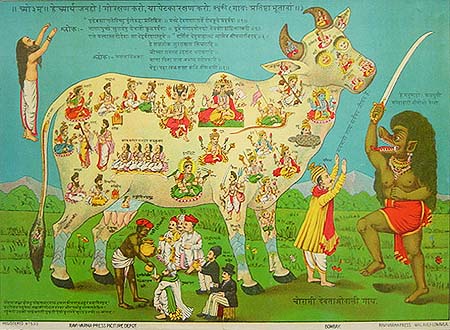Onni Gust with Radhika Govindrajan
Elections in India are drawing to a close with results pending. Amongst the 814 million eligible to vote are 28 000 gender non-conforming people, many of whom are hijra, who can now register as “third gender.” The competition for seats in the Lok Sabha, India’s lower house of Parliament, is primarily between two contenders. The Congress Party is led by the current prime minister Manmohan Singh, with Rahul Gandhi, and the right-wing, Hindu-nationalist, Bharatiya Janata Party has Narendra Modi at its head.

Although not central to the election campaigns of either of the two main parties, gender and sexuality has had an important role in recent public debates. The horrific gang rape and murder of a young woman in Delhi last year sparked discussions about the threat posed by men to women in rural and urban India, gender-based violence and attitudes towards female sexuality. The re-criminalization of homosexuality and the classification of hijras and other gender non-conforming people as “transgender” or “third gender” has raised awareness of minority genders and sexualities. Issues of gender and sexuality in India are wide-ranging and complex, but are often united by their discursive framing around a dichotomy of “tradition” versus “modernity.” Which practices, identities and attitudes count as “authentically Indian” and which can be dismissed as “corrupt,” “Western” imports?
That dichotomy of the “traditional” versus the “modern” is nowhere more evident than on the bumper stickers brought out by a pro-BJP youth group, the Namocars, which asks, “Kisey Chunenge? Gau Rakhsa Ya Gay Rakhsa?” – “Who will you choose? Cow Protection or Gay Protection.” The choice to be made, it suggests, is between “traditional” Hindu values and the “modern” and implicitly “un-Indian” phenomenon of homosexuality and gay identity. To understand the irony of this, we need to look to the late nineteenth century, when homosexuality was criminalized in the British Empire and cow protection institutionalized.
The same period that witnessed the criminalization and pathologization of homosexuality also saw the projection of the sacred cow as an emotive symbol of Hindu community. After the publication of Dayanand Saraswati’s Gokarunanidhi in 1881, cow-protection organizations sprung up across Northern India. These organizations incited riots and violence against those seen as threats to the “Hindu” nation embodied in the cow, targetting Muslims and dalit (formerly “untouchable” Hindus). The Cow Protection movement relied upon a strongly gendered imagery, in which the cow represented the mother of the Hindu nation, sometimes a ferocious goddess and other times a nurturing, maternal figure. Her protection fell to a nation imagined as male, hyper-masculine, heterosexual and Hindu. In the highly gendered, religious nationalism of the 1880s, which has influenced contemporary Hindu nationalism, there was little room for alternative genders and sexualities.
Far from tradition versus modernity, it is, in fact, at this moment at the height of British imperial power in India and emerging contested visions of the nation that both “cow protection” and what we could perhaps call “gay identity” have their genesis.
Further Reading:
Charu Gupta, “The Icon of Mother in Late Colonial North India: “Bharat Mata”, “Matri Bhasha” and “Gau Mata,” Economic and Political Weekly, vol 36, No.45 (Nov 10-16, 2001), 4291-4299.
 Onni Gust is Mellon post-doctoral fellow at the University of Illinois Champaign-Urbana, researching and teaching on early-nineteenth century gender formation in the context of European imperial expansion, particularly in India. Onni teaches European Imperial History and Gender and Sexuality Studies, works with LGBT youth and takes part in queer anti-racist and trans activism in the UK and USA.
Onni Gust is Mellon post-doctoral fellow at the University of Illinois Champaign-Urbana, researching and teaching on early-nineteenth century gender formation in the context of European imperial expansion, particularly in India. Onni teaches European Imperial History and Gender and Sexuality Studies, works with LGBT youth and takes part in queer anti-racist and trans activism in the UK and USA.

NOTCHES: (re)marks on the history of sexuality is licensed under a Creative Commons Attribution-NonCommercial-NoDerivatives 4.0 International License.
Based on a work at www.notchesblog.com.
For permission to publish any NOTCHES post in whole or in part please contact the editors at NotchesBlog@gmail.com





Hey, that was a wonderful article and a nice analysis of things
I don’t understand the reason behind the article. As far as the constitution of India is concerned, the directive principles of state policy states that–
The State shall promote with special care the educational and economic interests of the weaker sections of the people, and, in particular, of the Scheduled Castes and the Scheduled Tribes, and shall protect them from social injustice and all forms of exploitation.
LGBT groups are clearly weak in India.
The Directive priniciples further say that-
The State shall endeavour to organise agriculture and animal husbandry on modern and scientific lines and shall, in particular, take steps for preserving and improving the breeds, and prohibiting the slaughter, of cows and calves and other milch and draught cattle.
Yet we see a pink revolution in India as well as harrasment of sexual minorities.
Point to be noted here is that India has been ruled by Hindu nationalists only for 5-6 years(and then too they diluted their main agenda). Apart from that it has been ruled by those who called for emancipation of poor,minorities and what-not. They didn’t give the LGBT justice. Courts mustn’t be blamed either for they are bound by the law. So before blaming the hindu right wing, you should blame the spineless lefties(Congress and the so called socialists) and commies who can allow cow-slaughter in their states but can’t give the sexual minorities their due.
It is certainly true that there has been little room for sexual and gender minorities in either Left-wing or Right-wing politics, at least until very recently. But the post refers to the Hindu Right because the bumper stickers that inspired the post come from a group that was using the slogan to actively support the BJP. It is the Hindu Right that more frequently invokes “Hindu tradition” versus Western-influenced “modernity” as the basis for its claims to legitimacy.
MLK junior, said that their fight is not against the white supremacists but against the white liberals who wanted to maintain status quo. If you are so much concerned about LGBT rights then your fight is misdirected.
this comes at a right time and I thoroughly enjoyed reading ur analysis